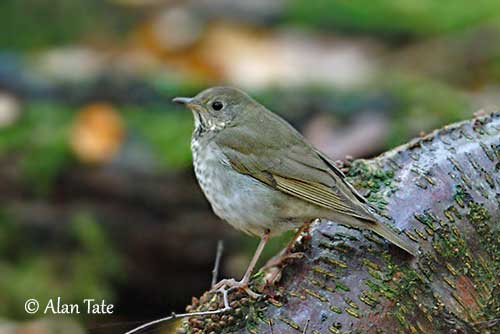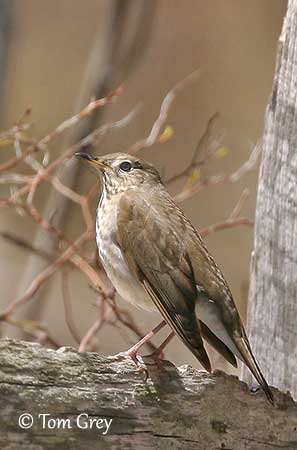
Fr: Grive à joues grises
Ang: Grey-cheeked Thrush
All: Grauwangendrossel
Esp: Zorzalito Carigrís
Ita: Tordo di Baird
Nd: Grijswangdwerglijster
Sd: gråkindad skogstrast
Photographers:
Tom Grey
Tom Grey's Bird Pictures & Tom Grey's Bird Pictures 2
Tom Merigan
Tom Merigan’s Photo Galleries
Alan & Ann Tate
AA Bird Photography
Text by Nicole Bouglouan
Sources:
HANDBOOK OF THE BIRDS OF THE WORLD Vol 10 by Josep del Hoyo-Andrew Elliott-David Christie - Lynx Edicions - ISBN: 8487334725
THRUSHES by Peter Clement and Ren Hathway – HELM - ISBN: 0713639407
THE HANDBOOK OF BIRD IDENTIFICATION FOR EUROPE AND THE WESTERN PALEARCTIC by Mark Beaman, Steve Madge - C. Helm - ISBN: 0713639601
All About Birds (Cornell Lab of Ornithology)
Wikipedia, the free encyclopaedia
The Birds of North America online
What Bird-The ultimate Bird Guide (Mitchell Waite)
Grey-cheeked Thrush
Catharus minimus
Passeriformes Order – Turdidae Family
INTRODUCTION:
The Grey-cheeked Thrush is shy and retiring, often hidden among the thick vegetation. It spends much time on the ground while searching for prey, usually alone or in pairs.
This monogamous species breeds in taiga and adjacent tundra, in undergrowth in boreal coniferous forests and often near streams. The compact, deep, cup-shaped nest is placed in shrub, tree or fallen trunk.
The Grey-cheeked Thrush is a long-distance migrant. It breeds in NE Siberia, Alaska and Canada, and winters in N South America, E of Andes.
This species has large range, but its reclusive habits make this bird difficult to observe. It is not globally threatened but the population trend is unknown.

DESCRIPTION OF THE BIRD:
Biometrics:
Length: 17-18 cm
Weight in May-June: M: 26-34 g – F: 27-36 g
Weight in October: M: 30-50 g – F: 30-45 g
The Grey-cheeked Thrush adult of nominate race has olive upperparts with grey-brown tinge.
The underparts are whitish with dark spots on the pale yellowish breast. Flanks are washed grey-brown, whereas the area from belly to undertail-coverts is white with grey wash.
On the head, forehead, crown and nape are like the upperparts. The face is greyish with indistinct pale eyering. A dark brown malar stripe extends down to neck sides and breast.
The bill is dark horn with pale pinkish (winter plumage) to orange-yellow (breeding plumage) base of lower mandible. The eyes are dark brown. Legs and feet are flesh-coloured to pale pinkish.
Male and female are similar.
The juvenile resembles adult, but the upperparts are spotted and streaked pale buff, and the greater coverts are tipped pale buff. The underparts are barred grey-brown.
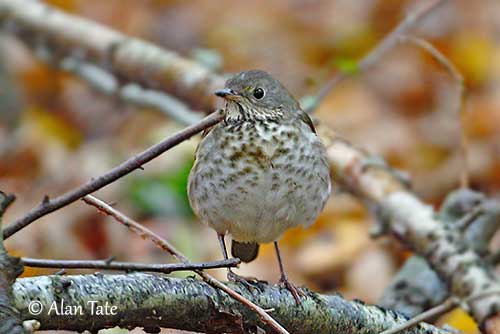
SUBSPECIES AND RANGE:
The Grey-cheeked Thrush has two subspecies.
C.m. aliciae breeds in NE Siberia (E from R Kolyma), Alaska and Canada. It winters in N South America, E of Andes. It is scarce in Greater Antilles.
This race is slightly larger than nominate, with colder olive to brownish-olive plumage above, especially on crown. The underparts are duller, with flanks washed brownish-olive.
C.m. minimus (described above) breeds in E Canada (Newfoundland and possibly N Quebec). It winters in N South America, E of Andes.
HABITAT:
The Grey-cheeked Thrush breeds in undergrowth in dense stands of conifers, in mixed deciduous and fir forests with shrubby thickets, dwarf willows and alders, in wet areas up to 1,000 metres of elevation, and also in brushy areas along the tundra edge beyond the treeline. It may breed in more open forests in E of the range.
During winter, it frequents mostly the lower levels of forests in tropical and subtropical regions. It can be seen at forest edges and in more open areas, in secondary growths with dense undergrowth, in old or abandoned plantations and damp thickets.
On migration, it frequents all suitable habitats such as woods, thickets, low coastal scrub, parks and gardens.
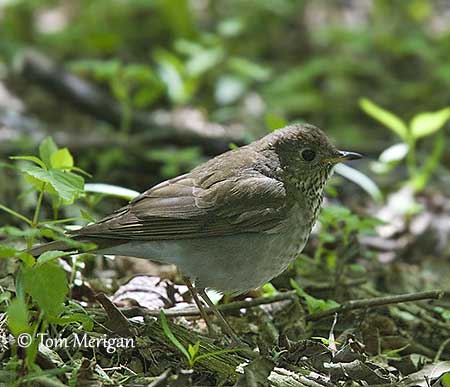
CALLS AND SONGS: SOUNDS BY XENO-CANTO
The Grey-cheeked Thrush’s typical calls include a quiet “zip” and a low, slurred “wee-ah”. A piercing “pweep” is used as contact at night during migration. Bill-snapping can be heard during aggressive encounters.
The song includes several high-pitched notes, a complex series descending in pitch and sometimes prolonged into short trills described as “ch-ch zreeew zi-zi-zreeew”.
This song is given by the male from exposed perches on treetops, but also from lower bushes and in short song-flights. It can be heard at dawn and dusk and through the night.
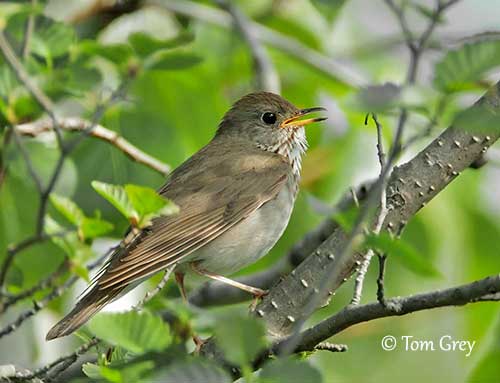
BEHAVIOUR IN THE WILD:
The Grey-cheeked Thrush feeds primarily on various insects such as beetles, ants, some bees and wasps, grasshoppers, moths and caterpillars. It also takes spiders and consumes seeds, fruits and berries depending on the season.
Like most Turdidae, it forages mainly on the ground by walking and hopping about in typical thrush-like pose, hopping, and then stopping to wait and search for prey. It forages under cover in low branches and on the ground among the leaf-litter.
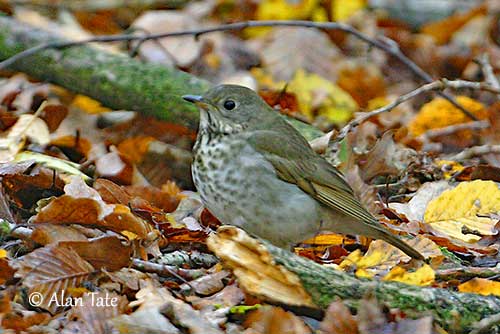
At the beginning of the breeding season, the male arrives first. It establishes the territory and frequently sings from exposed perches. During the courtship displays, the male pursues the female in fast flight among trees. They are monogamous.
The Grey-cheeked Thrush is a long-distance migrant and it moves mainly at night. It is more often heard than seen during migration. It may cover distances of up to 200 kilometres a day during the spring migration.
Vagrants are recorded in W Palearctic, most of them in Britain, with peak in October.
It has fairly fast, direct flight with somewhat jerky wingbeats.
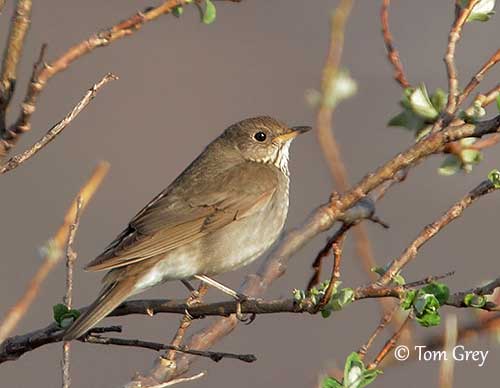
REPRODUCTION OF THIS SPECIES:
The breeding season takes place from mid-May to early August in North America and in June/July in Siberia. This species produces a single brood per season.
The nest is a deep, cup-shaped structure made with fine grasses, leaves, sedges, thin strips of bark and some moss held together with mud in order to form a compact structure. The cup is lined with finer grasses. It is placed in willows or alders up to 6 metres above the ground, sometimes also on fallen trunks.
The female lays 3-5 dull greenish-blue eggs with dark markings. The female incubates alone during 12-14 days. The chicks leave the nest 11-13 days after hatching, but they still depend on adults during at least 8 days, but probably more.
Both adults share the nesting duties, but only the female incubates.
PROTECTION / THREATS / STATUS:
The Grey-cheeked Thrush may be fairly common in suitable habitat, but this species is very shy and secretive, and very difficult to observe. It is probably more abundant than previously thought. Habitat modification may have an impact on numbers.
The Grey-cheeked Thrush has large range and the species is not globally threatened. It is currently evaluated as Least Concern.
